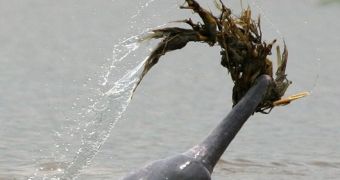A man will spend money on expensive gifts, best wine, finest sweets and flowers. But in the murky waters of the Amazon, boto or the Amazon River dolphin (Inia geoffroyensis) (which also inhabits the Orinoco River) males offer branches, rocks, weeds and lumps of clay to their females, in a parade also intended to chase away sex competitors. The art of conquering a dolphin girl and keeping the other males at bay seems to be a learned cultural behavior.
British-Brazilian researchers found that adult male botos carry these objects while surrounded by females, and thrash them on the water surface aggressively. The behavior is reported throughout the dolphin's areal in Brazil, Venezuela and Bolivia, being an unique sexual habit amongst mammals.
The research published in the journal Biology Letters shows this is not practiced by any other marine cetacean. The unique courtship behavior was investigated over three years in the Mamiraua Reserve, a flooded rainforest area on the Amazon. Still, this could be valid for more populations of the species, as the behavior was observed in many isolated groups of boto dolphins, throughout South America.
The behavior was not instinctual, as many dolphin population did not display it. The "weeders" were the most prolific male breeders, real dolphin studs.
"You see them coming up with bits of wood or lumps of rock in a very ritualized manner. Quite often they'd slowly come up above the surface in a vertical posture holding this stuff in their mouths, then sink down rotating on their own axis. They would also throw it or smash it against the surface, and it does appear that the waving around and bashing is to impress the ladies; but at the same time there's a lot of aggression between adult males, and we have to infer that's part of it," Tony Martin from the Sea Mammal Research Unit at St Andrews University told BBC News.
Mainly adult males employed this behavior especially when lots of adult females were present. Male aggressiveness was higher at that time, but they never hit each other with transported objects.
"Only chimps do anything similar - and that's much less sophisticated," said Martin.
Dolphins communicate mainly via sound, and this display may have an impressive auditory impact on the individuals of both sexes.
The study is part of the Projeto Boto, whose purpose is to conserve boto and its habitat.
River dolphins are extremely vulnerable; the baiji of the Chinese Yangtze River is already extinct, while the Indus or blind river dolphin species of South Asia counts no more than 3,000 individuals. Boto has the highest number, of tens of thousands, but its future is bleak as well, due to dams (which fragment and isolate its habitat) and pollution, like mercury from gold mining.
"With growing human populations in Amazonia and Orinoquia, the conflicts between fisheries and dolphins are certain to intensify," said Martin.
Moreover, fishermen are increasingly using boto meat as bait for fish, like the piracatinga, a catfish species (Calophysus macropterus). Caymans too are massacred for the same purpose. Projeto Boto researchers regularly find dead dolphins, harpooned or caught in nets.
"They may be fairly numerous now, but they're going downhill fast and we can't see any end to it," said Martin.
Dolphins are known to have a "culture", and their calls differ from population to population even inside the same species. In Australia, some bottlenose dolphins employ tools, like broken pieces of sponge around their noses in order to protect their snouts while foraging or against predators. But they do not use objects for socio-sexual display. Those acrobatic breaches executed by sea dolphins are rather meant for getting sex. In the murky waters of Amazon, this would not work.

 14 DAY TRIAL //
14 DAY TRIAL // 
